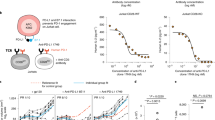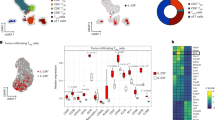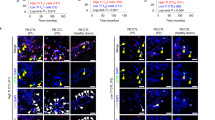Abstract
Programmed cell death protein 1 (PD-1) ligation delimits immunogenic responses in T cells. However, the consequences of programmed cell death 1 ligand 1 (PD-L1) ligation in T cells are uncertain. We found that T cell expression of PD-L1 in cancer was regulated by tumor antigen and sterile inflammatory cues. PD-L1+ T cells exerted tumor-promoting tolerance via three distinct mechanisms: (1) binding of PD-L1 induced STAT3-dependent ‘back-signaling’ in CD4+ T cells, which prevented activation, reduced TH1-polarization and directed TH17-differentiation. PD-L1 signaling also induced an anergic T-bet−IFN-γ− phenotype in CD8+ T cells and was equally suppressive compared to PD-1 signaling; (2) PD-L1+ T cells restrained effector T cells via the canonical PD-L1–PD-1 axis and were sufficient to accelerate tumorigenesis, even in the absence of endogenous PD-L1; (3) PD-L1+ T cells engaged PD-1+ macrophages, inducing an alternative M2-like program, which had crippling effects on adaptive antitumor immunity. Collectively, we demonstrate that PD-L1+ T cells have diverse tolerogenic effects on tumor immunity.
This is a preview of subscription content, access via your institution
Access options
Access Nature and 54 other Nature Portfolio journals
Get Nature+, our best-value online-access subscription
$29.99 / 30 days
cancel any time
Subscribe to this journal
Receive 12 print issues and online access
$209.00 per year
only $17.42 per issue
Buy this article
- Purchase on Springer Link
- Instant access to full article PDF
Prices may be subject to local taxes which are calculated during checkout







Similar content being viewed by others
Data availability
Sequence data are available in the Gene Expression Omnibus (GEO) database at NCBI under accession code GSE145905.
References
Kythreotou, A., Siddique, A., Mauri, F. A., Bower, M. & Pinato, D. J. PD-L1. J. Clin. Pathol. 71, 189–194 (2018).
Ribas, A. & Wolchok, J. D. Cancer immunotherapy using checkpoint blockade. Science 359, 1350–1355 (2018).
Juneja, V. R. et al. PD-L1 on tumor cells is sufficient for immune evasion in immunogenic tumors and inhibits CD8 T cell cytotoxicity. J. Exp. Med. 214, 895–904 (2017).
Dong, H. et al. Costimulating aberrant T cell responses by B7-H1 autoantibodies in rheumatoid arthritis. J. Clin. Invest. 111, 363–370 (2003).
Pulko, V. et al. B7-H1 expressed by activated CD8 T cells is essential for their survival. J. Immunol. 187, 5606–5614 (2011).
Liu, X. et al. B7-H1 antibodies lose antitumor activity due to activation of p38 MAPK that leads to apoptosis of tumor-reactive CD8+ T cells. Sci. Rep. 6, 36722 (2016).
Clark, C. E. et al. Dynamics of the immune reaction to pancreatic cancer from inception to invasion. Cancer Res. 67, 9518–9527 (2007).
Wang, W. et al. RIP1 kinase drives macrophage-mediated adaptive immune tolerance in pancreatic cancer. Cancer Cell 34, 757–774.e7 (2018).
Loke, P. & Allison, J. P. PD-L1 and PD-L2 are differentially regulated by TH1 and TH2 cells. Proc. Natl Acad. Sci. USA 100, 5336–5341 (2003).
Thorn, M. et al. Tumor-associated GM-CSF overexpression induces immunoinhibitory molecules via STAT3 in myeloid-suppressor cells infiltrating liver metastases. Cancer Gene Ther. 23, 188–198 (2016).
Horlad, H. et al. An IL-27/Stat3 axis induces expression of programmed cell death 1 ligands (PD-L1/2) on infiltrating macrophages in lymphoma. Cancer Sci. 107, 1696–1704 (2016).
Yang, B. et al. The role of interleukin 17 in tumour proliferation, angiogenesis, and metastasis. Mediators Inflamm. 2014, 623759 (2014).
Blogowski, W. et al. Selected cytokines in patients with pancreatic cancer: a preliminary report. PLoS One 9, e97613 (2014).
Jenkins, R. W. et al. Ex vivo profiling of PD-1 blockade using organotypic tumor spheroids. Cancer Discov. 8, 196–215 (2018).
Afkarian, M. et al. T-bet is a STAT1-induced regulator of IL-12R expression in naive CD4+ T cells. Nat. Immunol. 3, 549–557 (2002).
Yoon, J.-H. et al. Phosphorylation status determines the opposing functions of Smad2/Smad3 as STAT3 cofactors in TH17 differentiation. Nat. Commun. 6, 7600 (2015).
Chen, Z. et al. Selective regulatory function of Socs3 in the formation of IL-17-secreting T cells. Proc. Natl Acad. Sci. USA 103, 8137–8142 (2006).
Oh, H.-M., Yu, C. R., Dambuza, I., Marrero, B. & Egwuagu, C. E. STAT3 protein interacts with Class O Forkhead transcription factors in the cytoplasm and regulates nuclear/cytoplasmic localization of FoxO1 and FoxO3a proteins in CD4+ T cells. J. Biol. Chem. 287, 30436–30443 (2012).
Coffre, M. et al. miRNAs are essential for the regulation of the PI3K/AKT/FOXO pathway and receptor editing during B cell maturation. Cell Rep. 17, 2271–2285 (2016).
Procaccia, S., Ordan, M., Cohen, I., Bendetz-Nezer, S. & Seger, R. Direct binding of MEK1 and MEK2 to AKT induces Foxo1 phosphorylation, cellular migration and metastasis. Sci. Rep. 7, 43078 (2017).
Gordon, S. R. et al. PD-1 expression by tumour-associated macrophages inhibits phagocytosis and tumour immunity. Nature 545, 495–499 (2017).
Sica, A., Invernizzi, P. & Mantovani, A. Macrophage plasticity and polarization in liver homeostasis and pathology. Hepatology 59, 2034–2042 (2014).
Vergadi, E., Ieronymaki, E., Lyroni, K., Vaporidi, K. & Tsatsanis, C. Akt signaling pathway in macrophage activation and M1/M2 polarization. J. Immunol. 198, 1006–1014 (2017).
Amarnath, S. et al. The PDL1-PD1 axis converts human TH1 cells into regulatory T cells. Sci. Transl. Med. 3, 111ra120 (2011).
Daley, D. et al. γδ T cells support pancreatic oncogenesis by restraining αβ T cell activation. Cell 166, 1485–1499.e15 (2016).
Winograd, R. et al. Induction of T-cell immunity overcomes complete resistance to PD-1 and CTLA-4 blockade and improves survival in pancreatic carcinoma. Cancer Immunol. Res. 3, 399–411 (2015).
Gato-Canas, M. et al. PDL1 signals through conserved sequence motifs to overcome interferon-mediated cytotoxicity. Cell Rep. 20, 1818–1829 (2017).
Melton, A. C. et al. Regulation of IL-17A production is distinct from IL-17F in a primary human cell co-culture model of T cell-mediated B cell activation. PLoS One 8, e58966 (2013).
Gomez-Rodriguez, J. et al. Differential expression of interleukin-17A and -17F is coupled to T cell receptor signaling via inducible T cell kinase. Immunity 31, 587–597 (2009).
McAllister, F. et al. Oncogenic Kras activates a hematopoietic-to-epithelial IL-17 signaling axis in preinvasive pancreatic neoplasia. Cancer Cell 25, 621–637 (2014).
Chen, C. L. et al. IL-17 induces antitumor immunity by promoting beneficial neutrophil recruitment and activation in esophageal squamous cell carcinoma. Oncoimmunology 7, e1373234 (2017).
Benchetrit, F. et al. Interleukin-17 inhibits tumor cell growth by means of a T-cell-dependent mechanism. Blood 99, 2114–2121 (2002).
Corcoran, R. B. et al. STAT3 plays a critical role in KRAS-induced pancreatic tumorigenesis. Cancer Res. 71, 5020–5029 (2011).
Fukuda, A. et al. Stat3 and MMP7 contribute to pancreatic ductal adenocarcinoma initiation and progression. Cancer Cell 19, 441–455 (2011).
Daley, D. et al. Dectin 1 activation on macrophages by galectin 9 promotes pancreatic carcinoma and peritumoral immune tolerance. Nat. Med. 23, 556–567 (2017).
Mantovani, A., Marchesi, F., Malesci, A., Laghi, L. & Allavena, P. Tumour-associated macrophages as treatment targets in oncology. Nat. Rev. Clin. Oncol. 14, 399–416 (2017).
Talay, O., Shen, C. H., Chen, L. & Chen, J. B7-H1 (PD-L1) on T cells is required for T-cell-mediated conditioning of dendritic cell maturation. Proc. Natl Acad. Sci. USA 106, 2741–2746 (2009).
Zambirinis, C. P. et al. TLR9 ligation in pancreatic stellate cells promotes tumorigenesis. J. Exp. Med. 212, 2077–2094 (2015).
Pushalkar, S. et al. The pancreatic cancer microbiome promotes oncogenesis by induction of innate and adaptive immune suppression. Cancer Discov. 8, 403–416 (2018).
Ochi, A. et al. MyD88 inhibition amplifies dendritic cell capacity to promote pancreatic carcinogenesis via TH2 cells. J. Exp. Med. 209, 1671–1687 (2012).
Bedrosian, A. S. et al. Dendritic cells promote pancreatic viability in mice with acute pancreatitis. Gastroenterology 141, 1915–1926.e14 (2011).
Greco, S. H. et al. Mincle suppresses Toll-like receptor 4 activation. J. Leukoc. Biol. 100, 185–194 (2016).
Rehman, A. et al. Role of fatty-acid synthesis in dendritic cell generation and function. J. Immunol. 190, 4640–4649 (2013).
Dobin, A. et al. STAR: ultrafast universal RNA-seq aligner. Bioinformatics 29, 15–21 (2013).
Liao, Y., Smyth, G. K. & Shi, W. featureCounts: an efficient general purpose program for assigning sequence reads to genomic features. Bioinformatics 30, 923–930 (2014).
Love, M. I., Huber, W. & Anders, S. Moderated estimation of fold change and dispersion for RNA-seq data with DESeq2. Genome Biol. 15, 550 (2014).
Shannon, P. et al. Cytoscape: a software environment for integrated models of biomolecular interaction networks. Genome Res. 13, 2498–2504 (2003).
Jenkins, R. W. et al. Ex vivo profiling of PD-1 blockade using organotypic tumor spheroids. Cancer Discov. 8, 196–215 (2017).
Acknowledgements
We acknowledge the use of the Genome Technology, Experimental Pathology and Flow Cytometry core facilities at NYU School of Medicine. These shared resources are partially supported by the Cancer Center Support Grant, P30CA016087, at the Laura and Isaac Perlmutter Cancer Center. The Vectra3 imaging system was purchased through NIH Shared Instrument Grant S10 OD021747. This work was supported by the American College of Surgeons Resident Research Fellowship (B.D.) and NIH grants CA168611 (G.M.), CA203105 (G.M.), CA215471 (G.M.), CA19311 (G.M.) and DK106025 (G.M.).
Author information
Authors and Affiliations
Contributions
B.D. and S.A. prepared the manuscript, performed in vivo and in vitro experiments and data analysis, and designed, supervised and interpreted the study; M.F.C., G.S., R.D.S., D.W., C.F., K.H.T. and T.C. performed in vitro experiments; M.L, C.B, E.L., B.S., R.C., J.W. and Z.S. performed in vivo experiments in addition to manuscript and figure preparation; M.K. performed data analyis; B.A., M.S.F., S.N., J.A.K.R., E. Kruger, M.I.U.H. and J.K. performed in vivo experiments, data analysis and manuscript review; W.W., M.H. S.A.A.S, G.B., G.W., K.-K.W., J.L. and E. Kurz performed data analysis and critical review; S.S. and C.L. performed immunofluorescence; G.M. conceived, designed, supervised, analyzed and interpreted the study and provided critical review, and is senior author and corresponding author.
Corresponding author
Ethics declarations
Competing interests
G.M. has research agreements with GSK, Pfizer and Puretech Health. K.K.W. is a founder and equity holder of G1 Therapeutics and has sponsored research agreements with MedImmune, Takeda, TargImmune, Bristol-Myers Squibb, Mirati, Merus and Alkermes, and has consulting and sponsored research agreements with AstraZeneca, Janssen, Pfizer, Novartis, Merck, Ono and Array. The remaining authors declare no competing interests.
Additional information
Peer review information Zoltan Fehervari was the primary editor on this article and managed its editorial process and peer review in collaboration with the rest of the editorial team.
Publisher’s note Springer Nature remains neutral with regard to jurisdictional claims in published maps and institutional affiliations.
Supplementary information
Supplementary Information
Supplementary Figs. 1–9.
Rights and permissions
About this article
Cite this article
Diskin, B., Adam, S., Cassini, M.F. et al. PD-L1 engagement on T cells promotes self-tolerance and suppression of neighboring macrophages and effector T cells in cancer. Nat Immunol 21, 442–454 (2020). https://doi.org/10.1038/s41590-020-0620-x
Received:
Accepted:
Published:
Issue Date:
DOI: https://doi.org/10.1038/s41590-020-0620-x
This article is cited by
-
S100A9+CD14+ monocytes contribute to anti-PD-1 immunotherapy resistance in advanced hepatocellular carcinoma by attenuating T cell-mediated antitumor function
Journal of Experimental & Clinical Cancer Research (2024)
-
Modification of the tumor microenvironment enhances immunity with plasmid gene therapy
Cancer Gene Therapy (2024)
-
Synthetic dual co-stimulation increases the potency of HIT and TCR-targeted cell therapies
Nature Cancer (2024)
-
Efficacy of programmed cell death 1 inhibitor maintenance after chimeric antigen receptor T cells in patients with relapsed/refractory B-cell non-Hodgkin-lymphoma
Cellular Oncology (2024)
-
Targeting and cytotoxicity of chimeric antigen receptor T cells grafted with PD1 extramembrane domain
Experimental Hematology & Oncology (2023)



